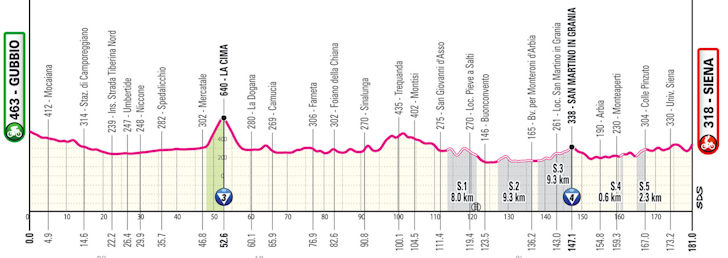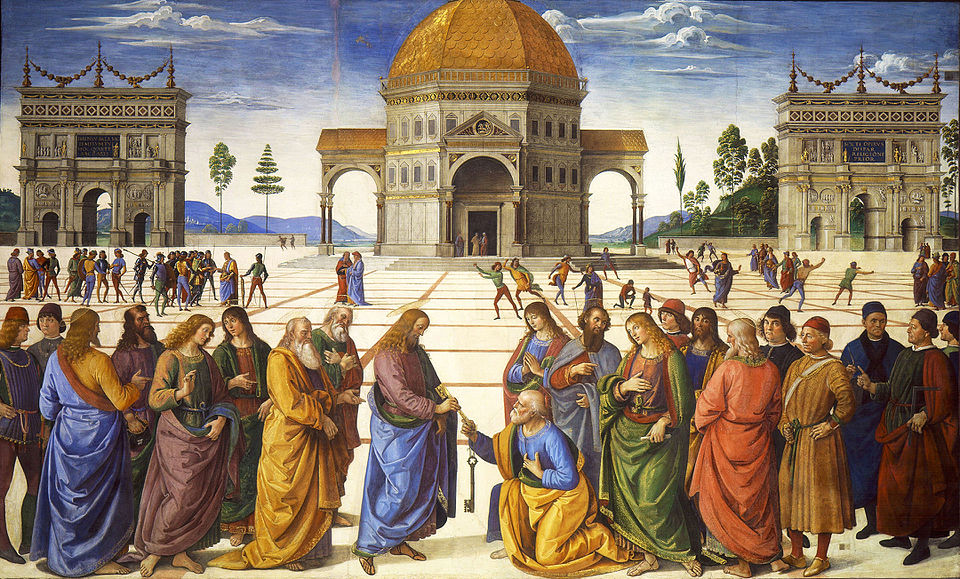Gubbio – Siena
18 May 2025
181 km
If Toscana (Tuscany), then Strade Biance-styled gravel stage at the Giro d'Italia

NEXT STAGES
Giro d’Italia 2025 Stage 10 Lucca – Pisa (28,6 km ITT)
After the second rest day, Giro d’Italia 2025 continues with a 28,6 km long individual time trial Lucca… Read More »Giro d’Italia 2025 Stage 10 Lucca – Pisa (28,6 km ITT)
Giro d’Italia 2025 Stage 11 Viareggio – Castelnovo ne’ Monti (185 km)
Viareggio – Castelnovo ne’ Monti 21 May 2025 185 km IMPORTART CLIMB OF THE DAY GENERAL… Read More »Giro d’Italia 2025 Stage 11 Viareggio – Castelnovo ne’ Monti (185 km)
Giro d’Italia 2025 Stage 12 Modena – Viadana (172 km)
Modena – Viadan 22 May 2025 172 km FACES FROM THE PELOTON/ITALIAN CYCLIST OF THE DAY Alfredo… Read More »Giro d’Italia 2025 Stage 12 Modena – Viadana (172 km)
Giro d’Italia 2025 Stage 13 Rovigo – Vicenza (180 km)
Rovigo – Vicenza 23 May 2025 180 km TAKE A LOOK AT STAGES 13 OF THE OTHER… Read More »Giro d’Italia 2025 Stage 13 Rovigo – Vicenza (180 km)
FACES FROM THE PELOTON /ITALIAN CYCLIST OF THE DAY
 Roberto Visentini, winner of Giro d'Italia 1986.
Roberto Visentini, winner of Giro d'Italia 1986.
Unfortunately, nowadays he is rsther known from the bitter intra-team rivalry between him and Stephen Roche during Giro d'Italia 1987.
TAKE A LOOK AT STAGES 9 OF THE OTHER GRAND TOURS
Take a look at the 9th stage of Tour de France 2025
Take a look at the 9th stage of La Vuelta 2025
IF YOU CAN'T STOP THINKING ABOUT THE ROMAN EMPIRE
Gubbio, known in ancient times as Iguvium, was an important city in Regio VI Umbria. Long before Roman domination, it was the center of the Umbrians, an Italic people with a rich culture.
Around the 3rd century BCE, the Umbrians of Iguvium created an extraordinary set of bronze tablets, now called the Eugubine Tables (Tabulae Iguvinae). These seven bronze plates, discovered in the 15th century but dating back to Roman times, contain ritual laws and religious ceremonies of the ancient Umbrian priests.
Legend says that the high priest of Iguvium, Aule Cluentius, received a divine vision from the gods Jupiter and Mars, instructing him to preserve the sacred laws of the city. To ensure these laws were never forgotten or lost, he ordered the creation of the bronze tablets inscribed with the rituals necessary to keep the city protected and prosperous.
The tablets were buried deep beneath the Palazzo dei Consoli in Gubbio, guarded by secret priestly families for centuries. According to the tale, these sacred laws had the power to bring rain to the fields, protect against invaders, and ensure justice among the people.
During Roman times, even after Iguvium became part of the empire, the city’s priests continued to perform rituals from the tables, blending Umbrian tradition with Roman religion. The careful preservation of these texts shows how Gubbio balanced its ancient roots with the broader Roman world.
The Eugubine Tables remain one of the most important archaeological discoveries from Umbria, offering a rare glimpse into the religious and civic life of ancient Italic peoples.
(HISTORICAL) NOVEL OF THE DAY
Michael Ondaatje: The English Patient
 The Hollywood film adaptation of this novel focused more on the forbidden romance between one of the protagonists and a married woman, but Michael Ondaatje's novel is actually much more about.
The Hollywood film adaptation of this novel focused more on the forbidden romance between one of the protagonists and a married woman, but Michael Ondaatje's novel is actually much more about.
During the end months of World War 2, an abandoned villa in Tuscany became a temporary home of four people with different backgrounds and different traumas.
One of them is an unrecognisably burned man without papers and without memories. In the hospital he was named simply "the English patient", because what else can be a white man with inpeccable manners and perfect posh English, whose only possession is an English translated ancient Greek history book, than an Englishman.
Well, he is not English, but a Hungarian count, Almasy, who was raised and lived among the British upper classes.
But in cases of many great novels, this one's title has a double meaning too. It turns out that metaphorically Kip, the young Sikh guy, a British army sapper is the actual English patient, because he desperately wants to be part of the Englishness. But unlike Almasy, he could be never be mistaken as an Eglish because of his brown skin colour.
ITALIAN PAINTING OF THE DAY

This fresco in Sistine Chapel (Vatican City) depicts a key moment from the New Testament (Matthew 16:18–19), where Jesus Christ gives the keys of the Kingdom of Heaven to Saint Peter. This act symbolizes the authority given to Peter and his successors, the Popes, to lead the Church.
Jesus is handing the large golden keys to Saint Peter, who kneels before him, accepting the responsibility.
The scene is set in an idealized classical courtyard, with balanced architecture in the background that showcases Perugino’s mastery of perspective. The colonnades lead your eye toward the central figures. Around them stand apostles and other followers, all observing the solemn moment.
The keys represent spiritual authority and the power to bind and loose, a foundation of Papal power.
The linear perspective creates a deep, harmonious space, emphasizing order and divine authority.
The Umbrian hills in the background are reflecting Perugino’s origins and the Renaissance ideal of harmony between nature and human creations.

